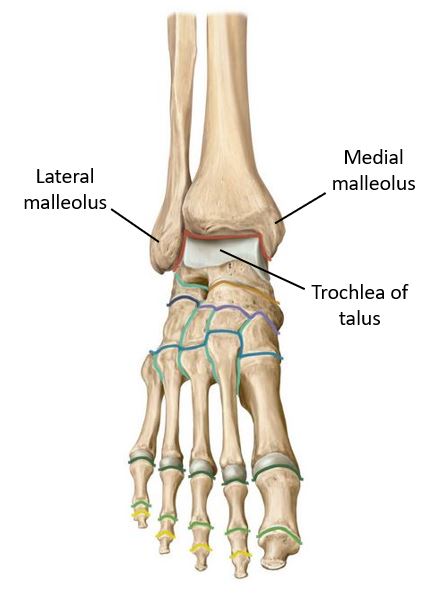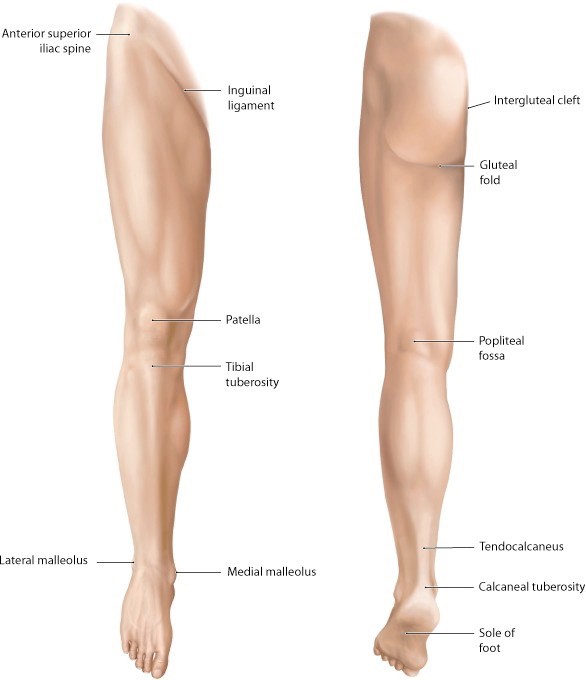The sensory cranial nerves
Cranial nerve I: Olfactory nerve Functions Olfaction (smell)—special sensory. Skull opening Olfactory (cribriform) foramina. Nucleus of origin/destination in CNS Bipolar neurons of olfactory nerves synapse on secondary olfactory neurons in olfactory bulbs. Details The ceilings of the nasal cavities are lined by a special olfactory epithelium that includes the peripheral processes of primary olfactory neurons […]
Cranial nerves
In this chapter Clinical testing of cranial nerves Students should have a basic understanding of how the functions of cranial nerves are tested clinically. Here are two examples of resources on the web. Although these in-depth exams are probably not practical in most situations, they provide nice demonstrations of testing techniques. How to Assess the […]
The foot
Optional Reading Clinically Oriented Anatomy, 8th ed., Bones of the foot section, The foot section. Before embarking on the anatomy of the foot, let’s keep in mind how it contrasts with the hand. The upper limb has great mobility and the hand has grasping and sensory functions. The lower limb in general is built for […]
Posterior leg
Posterior compartment of the leg 7 muscles arranged in a superficial layer (darker green in Figure 27.1) and deep layer (yellow in Figure 27.1) Superficial muscles: powerful plantar flexors because they support and move body weight All muscles in the posterior leg are innervated by the tibial nerve and supplied with blood by the posterior […]
Anterior and lateral leg: Ankle joint
Bones and fascia The deep fascia of the thigh (fascia lata) continues on to the leg, forming a dense, snug-fitting layer called the crural fascia The crural fascia, intermuscular septa, bones of the leg,and interosseous membrane separate the leg into anterior, lateral, and posterior compartments Figure 26.1 Clinical correlation: Compartment syndrome The deep fascia in […]
Lab 15: Anterior and Lateral Leg, Knee and Ankle Joints, and Dorsum of Foot

Download this lab as a PDF Goals Identify bony features associated with the knee, leg, and ankle. Identify the muscles in the anterior and lateral compartments of the leg and discuss their actions, innervations, and blood supply. Identify the muscles, nerves, and vessels on the dorsum of the foot. Identify the bones, ligaments, and cartilages […]
Lab 14: Gluteal Region, Posterior Thigh, and Popliteal Fossa

Download this lab as a PDF (Updated 28 October 2024, 8:42 a.m.) Goals Clean and identify the muscles, nerves, and vessels of the gluteal region. Identify the greater sciatic foramen and the structures that traverse it. Clean and identify the muscles, nerve, and vessels of the posterior compartment of the thigh. Identify the boundaries and […]
The knee joint
The knee is a modified hinge joint There are three articulations within the knee joint complex: Lateral and medial tibiofemoral and patellofemoral joints Movements can occur along two axes: The primary movements are flexion and extension Because the radii and lengths of the articular surfaces of the femur and tibia differ, there is a small […]
Gluteal region, posterior thigh, and popliteal fossa
Pertinent osteology Please review the anatomy of the acetabulum, posterior hip bone, sciatic notches, and femur. Figure 24.1 Osteology of the os coxae. Figure 24.2 Sciatic foramina. Figure 24.3 Osteology of the femur. Gluteal region Physically, the gluteal region is part of the trunk, but functionally, it is clearly part of the limb. The gluteal […]
The hip joint
Figure 23.1 The hip joint is the articulation between the round femoral head and the concave acetabulum (“little vinegar cup”). The lunate surface is the articular surface of the acetabulum, forming an arc that fills ¾ of the acetabular cup. It is covered with articular cartilage. The acetabulum is deepened by the acetabular labrum, a […]